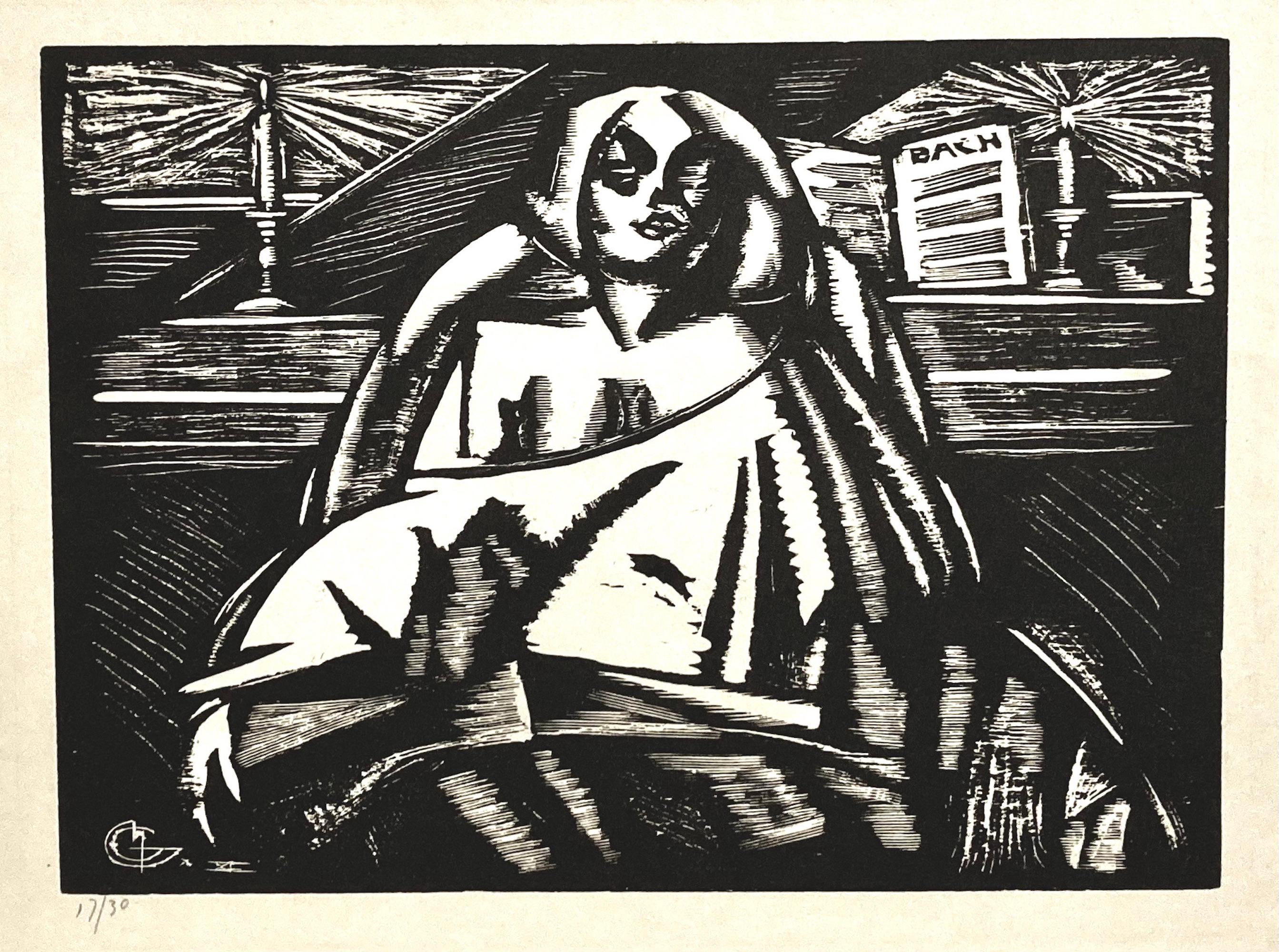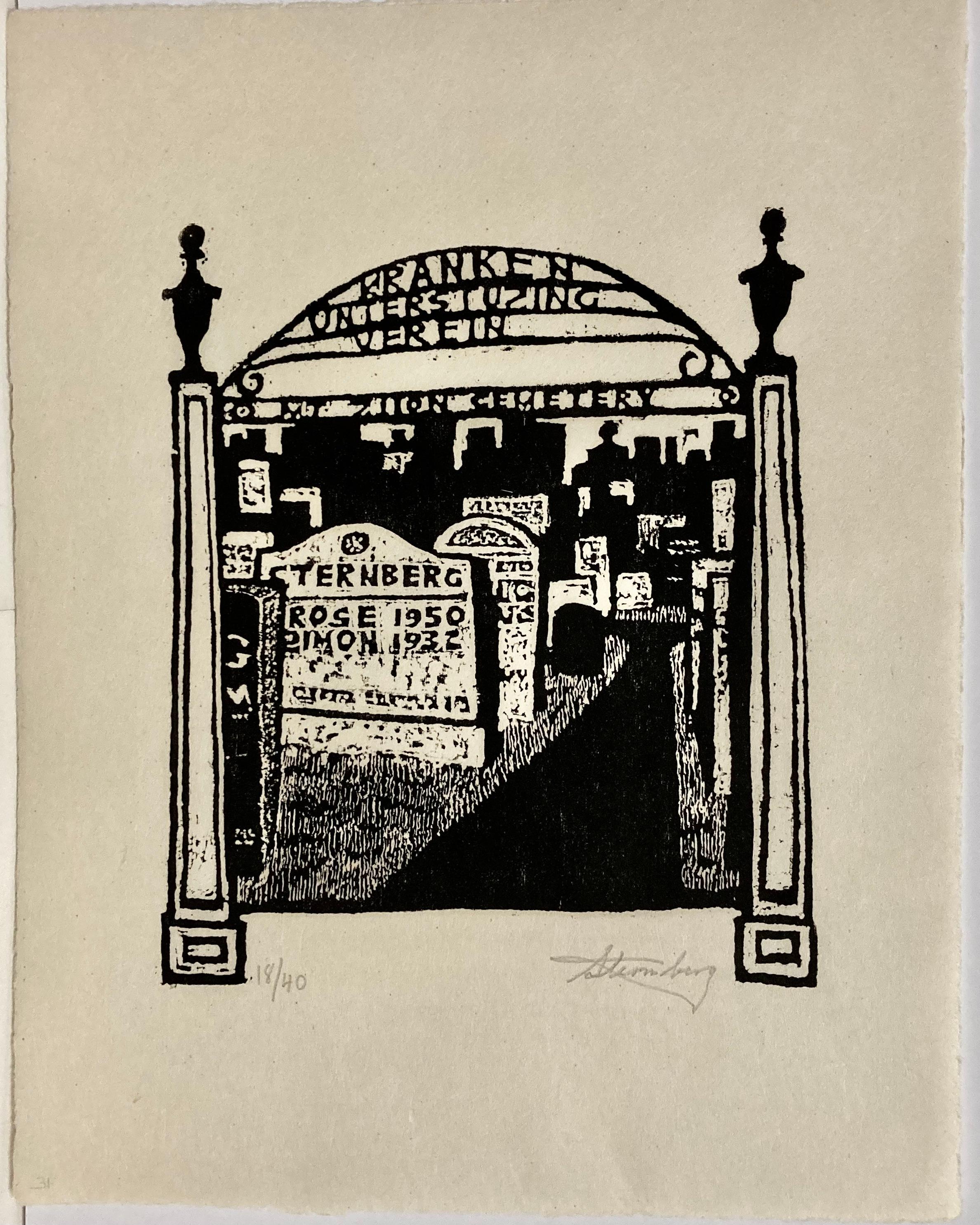Items Similar to Ex Libris - PF - Original Woodcut by M. Fingesten - Early 1900
Want more images or videos?
Request additional images or videos from the seller
1 of 3
Michel FingestenEx Libris - PF - Original Woodcut by M. Fingesten - Early 1900Early 1900
Early 1900
About the Item
Image dimensions: 8.8 x 5.5 cm.
Ex Libris - PF is an original xilograph artwork realized by Michel Fingesten in the 1930s
Hand-signed on the lower center and hand written notes.
Mint conditions except for some foxings.
Includes passepartout : 49 x 34 cm
Ex Libris is a Latin phrase meaning a bookplate that identifies the owner of the book into which it is pasted.
Michel Fingesten
Michel Finkelstein, known as Fingesten, was born in 1884 in Buzkovice u Ostravy; he was a painter and engraver, who was famous particularly for his extraordinary production of Ex Libris (bookplates).
After studying at the Academy of Fine Arts in Vienna, and in Monaco with Franz von Stuck, who addressed him to the caricature and to the graphics of small size, Fingesten left Austria; he travelled all over the world, visiting Europe, the United States of America and the Oriental countries.
Fingesten’s stay in Berlin since 1913 was decisive for his contact with the world of the engraving. After his adhesion to the New Secession, Fingesten destroyed his previous pictorial production and he decided to dedicate himself to the dimension of the engraving; even if he preferred the graphics, he continued to see himself as a “painter”.
The German city was characterized by a very dynamic artistic atmosphere that stimulated Fingesten. The engravings of this artist were published since 1915 in files and books in limited edition.
Fingesten’s works were published also in the famous periodicals of the expressionist avant-garde, like “Genius” and “Marsyas”, with the artists and the writers most important of his age.
Considered as a genius of the Ex Libris, that became with him a big art of small size, Fingesten realised more over than 1.500 of these brands of property since 1915. Fingesten’s Ex Libris were nourishment for the bibliophiles, who glued the bookplates on the first page of theirs books to indicate the property and who traded these Ex Libris.
The Ex Libris is a genre that doesn’t have confines and that can’t be reduced to indicate the name of the owner on the book, on which it is glued.
It left his old function of simple heraldic sign of property, and it became almost the projection of the bibliophile’s personality.
Even if he didn’t fall in the eclecticism, Michel Fingesten used generously the medium of the quote, in the subject, in the form and in the style.
In the 20s, for example, his art oscillates between Otto Dix and George Grosz, of which he overcomes the social critique and the erotism, and Karl Arnold of which he beats the irony.
The Great Depression of 1929 and the rapid advance of the Nazism contributed in a significant way to the progressive isolation of the Czech painter and engraver.
In the spring of the 1935, Fingesten left Germany and went to Italy, where he settled in Trieste and Milan.
The collector Mantero remembers about Fingesten’s Italian stay that “he lived in a home without furnitures” in Via Chiaravalle 11.
Mantero, who was one of the most important Fingesten’s customers of Ex Libris, wrote: “I understood he had a difficult and poor life for absence of money, but he didn’t have ambition of a rich life, indeed he told me that the earnings to buy some bread and a glass of wine were enough for him”.
In that period, the main means of subsistence were the commissions of the collectors of Ex Libris, especially the collectors of Milan and Como, members of the circle of friends of the art merchant Luigi Filippo Bolaffio.
Also known as “Picasso of the Ex Libris”, Fingesten explored this artistic medium and he elevated it with new and powerful expressive resources.
When the Ex Libris was detached from its practical function, the Artist began to create Ex Libris also for fake customers, for “famous contemporary people”, poets, musicians, and since 1928, for political men.
The Ex Libris, realised with a lot of graphic techniques, like the etching, the drypoint and the lithography, has always (with the graphics of occasion) the signature of the Artist, that underlines the awareness of his valour.
An important chapter of the production of this Artist was dedicated to the erotic Ex Libris, that for their irony were understood with difficulty by people that didn’t belong to the circle of the Artist.
Some of the most secret and rare erotic works by Fingesten are linked to the commissions of Gianni Mantero.
The dominant element of these engravings is the sarcasm, that is sometimes connected to a gloomy irony, and to the presence of the death, that coincided with the war, particularly in the last years of the Artist existence.
In his compositions, Fingesten was a narrator of life and death, of sex and love, of nightmares, hopes, art and poetry. His narration wasn’t without the time and the space, but it was at the center of the contemporary dimension, in the 20s and 30s of the anguished Europe that was going to the ruin.
We can underline that the relationship between the Artist and the customer had an important role in the definition of the power of these graphic works; actually the creative energy, that was born from the contact between the Artist inspiration and the customer personality, generates a strong expressive freedom.
After his death, Michel Fingesten and his works were forgotten; today there is a new attention to this very important artist and to his visionary sign.
Bibliography
• N. Nechwatal, Michel Fingesten – Das graphische Werk, Coburg 1984
• A. Tomasetig, Michel Fingesten: dalla collezione Cauti una mostra di ex libris e grafica d’occasione, 2005
• A. Parik, The unknown Michel Fingesten, Praha 2008
This artwork is shipped from Italy. Under existing legislation, any artwork in Italy created over 70 years ago by an artist who has died requires a licence for export regardless of the work’s market price. The shipping may require additional handling days to require the licence according to the final destination of the artwork.
- Creator:Michel Fingesten (1884 - 1943, Italian)
- Creation Year:Early 1900
- Dimensions:Height: 4.93 in (12.5 cm)Width: 3.55 in (9 cm)Depth: 0.12 in (3 mm)
- Medium:
- Movement & Style:
- Period:
- Framing:Framing Options Available
- Condition:Insurance may be requested by customers as additional service, contact us for more information.
- Gallery Location:Roma, IT
- Reference Number:
About the Seller
4.9
Platinum Seller
These expertly vetted sellers are 1stDibs' most experienced sellers and are rated highest by our customers.
1stDibs seller since 2017
6,739 sales on 1stDibs
Typical response time: 2 hours
- ShippingRetrieving quote...Ships From: Rome, Italy
- Return PolicyA return for this item may be initiated within 14 days of delivery.
More From This SellerView All
- The Deep Conversation - Woodcut Print by Paul Baudier - 1930sLocated in Roma, ITThe Deep Conversation is a woodcut print on ivory-colored paper realized by Paul Baudier (1881-1962) in the 1930s. Good conditions. Paul Baudier, (born October 18, 1881 in Paris an...Category
1930s Modern Figurative Prints
MaterialsWoodcut
- The Buddhist Temple In China - Woodcut Print by Paul Baudier - 1930sLocated in Roma, ITThe Buddhist Temple In China is a woodcut print on ivory-colored paper realized by Paul Baudier( 1881-1962) in the 1930s. Good conditions with some spots. Paul Baudier, (born Octob...Category
1930s Modern Figurative Prints
MaterialsWoodcut
- View of Mount Fuji in Winter- Woodcut by Katsushika Hokusai - Early 20th centuryBy Katsushika HokusaiLocated in Roma, ITView of Mount Fuji in Winter is a woodcut print realized by Katsushika Hokusai in the early 19th Century, probably around 1835. From the book "Fugaku hyakkei" (100 views of Mount Fu...Category
Early 20th Century Modern Figurative Prints
MaterialsWoodcut
- The Sleeping Time - Woodcut Print by Paul Baudier - 1930sLocated in Roma, ITThe Sleeping Time is a woodcut print on ivory-colored paper realized by Paul Baudier (1881-1962) in the 1930s. Good conditions. Paul Baudier, (born October 18, 1881 in Paris and di...Category
1930s Modern Figurative Prints
MaterialsWoodcut
- The Manly Formality - Woodcut Print by Paul Baudier - 1930sLocated in Roma, ITThe Manly Formality is an original woodcut print on ivory-colored paper realized by Paul Baudier (1881-1962) in the 1930s. Good conditions. Paul Baudier, (born October 18, 1881 in ...Category
1930s Modern Figurative Prints
MaterialsWoodcut
- The Romance - Woodcut Print by Paul Baudier - 1930sLocated in Roma, ITThe Romance is a woodcut print on ivory-colored paper realized by Paul Baudier (1881-1962) in the 1930s. Good conditions. Paul Baudier, (born October 18...Category
1930s Modern Figurative Prints
MaterialsWoodcut
You May Also Like
- Henry Spanner, BeerLocated in New York, NYThis is among the very few prints known by Spanner. It's the epitome of joie de vivre. It is signed, numbered, and annotated 'Hand print,' in pencil. The numbering indicates an edit...Category
1930s American Modern Figurative Prints
MaterialsWoodcut
- Heinrich Glintenkamp, (Woman at Piano - Bach)By Heinrich GlintenkampLocated in New York, NYAn American painter, printmaker, and illustrator. His work was featured in "The Masses" and at the Metropolitan Museum of Art and Pennsylvania Academy of the Fine Arts. This wood en...Category
Mid-20th Century American Modern Interior Prints
MaterialsWoodcut
- Harry Sternberg, Mount Zion Cemetery, from My Life in Woodcuts, 1991By Harry SternbergLocated in New York, NYIn 1991 Harry Sternberg published a book with Brighton Press, San Diego. It was My Life in Woodcuts. At the time it was the only known woodcut autobiography. The deluxe editions of...Category
1990s American Modern Figurative Prints
MaterialsWoodcut
- Albert Abramovitz, Mission, CaliforniaBy Albert AbramovitzLocated in New York, NYAlbert Abramovitz was an amazingly skilled wood engraver. This California Mission scene is unusual in his work, but carries the subject so well. It is signed and titled in pencil.Category
1940s American Modern Figurative Prints
MaterialsWoodcut
- Sidney Chafetz, The Stroller (Wallace Stevens)Located in New York, NYSidney Chafetz was known for his clever compositions and his many portraits, all made in the most 'difficult to control' medium of woodcut.. This charmi...Category
1970s American Modern Figurative Prints
MaterialsWoodcut
- Harry Sternberg, Commercial High School from My Life in Woodcuts, 1991By Harry SternbergLocated in New York, NYIn 1991 Harry Sternberg published a book with Brighton Press, San Diego. It was My Life in Woodcuts. At the time it was the only known woodcut autobiography. The deluxe editions of...Category
1990s American Modern Figurative Prints
MaterialsWoodcut
Recently Viewed
View AllMore Ways To Browse
Original Fake
Secession Original
Antique Trade Sign Original
M Gianni
Antique Erotic Prints
American Depression Glass
Mens Gianni
Beats Antique
Czech Original Artwork
Otto Secession
Fine Karl Springer
Dior Wine Glasses
Picasso Woodcut
Antique German Wine Glasses
Picasso Erotic Art
Antique Sex
Antique Wine Prints
Men Erotic Art





